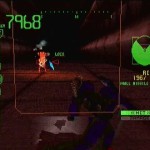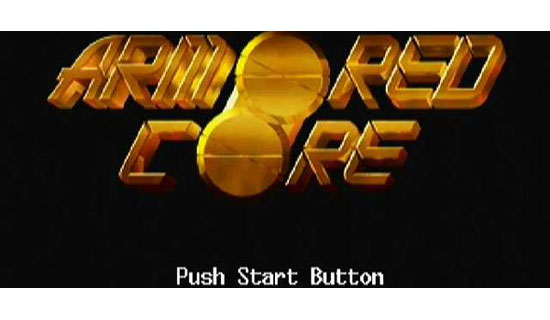Games that put the player in control of a mech (or a similar type of giant robot) have waxed and waned in popularity over the years, and have come in many different varieties. These days the Armored Core series is arguably a standard in mech games, having been around consistently since 1997 on the original Playstation. It was not, however, the inventor of the genre. Many would consider the inventor to be the MechWarrior series, which debuted on MS DOS in 1989 (and the Super NES in 1993). These were certainly some of the first games to place the player inside of the cockpit of a mech, presumably replicating the slow and lumbering feeling that one would experience from trudging across a battlefield in a giant robot that is not really all that mobile. Even the most popular entry in the MechWarrior series, MechWarrior 2 was released two years before Armored Core in 1995.
It could even be argued that there were mech games before the MechWarrior series. Mobile Suit Gundam, a series that features giant robots that aren’t quite mechs but are certainly close, had its first Famicom game in 1986. While half of the game was your traditional Japanese side-scrolling action game take on the robot (which did not replicate the feel in any way, though was certainly more accessible), the other half was was a first-person shooter which placed the player inside of the Gundam cockpit. Even BattleTech, the series from which MechWarrior was birthed, had an entry in 1994 for the Sega Genesis that took the series from a role-playing game to an overhead action game.
 |  |
| I should have known what I was in for when the game’s intro featured a menu… | Screenshots may not do it justice, but the graphics look pretty good for a 1997 3D Playstation game |
But regardless of what we define as the originator of the mech game genre, most will credit Armored Core from taking the genre from piloting a large lumbering robot to controlling a significantly speedier one in faster action environments. But was it really? Cyber Troopers Virtual-On (or Dennou Senki Virtual On) first hit arcades in 1995, and the Sega Saturn in 1996. Comparing these two series is apples to oranges though: Virtual-On is an extremely fast paced, arcade style game that plays very much like a fighting game with twin sticks. Whereas the action in Armored Core is faster than most of its predecessors, it’s not THAT fast.
What Armored Core excels at above all else is being a heaven for mech nerds. The game’s hub is just a menu that features options to go to the Garage (to equip parts), Shop, Ranking (To see rankings of your other squad members), Mail (You can receive emails from your squad) and Missions. This first installment is in fact a mission-based game that is very light on story, but very heavy on customization of your robot. We’re not just talking about some aesthetic customization that you can perform to it, or that you can actually use a crude piece of art software within the game to design an emblem to put on your robot. Armored Core features full customization: Head, Arms, Legs, Core, Generator, Boosters, FCS (Fire Control System, in other words weapon targeting) and Arm and Back Weapons. If you have the money, patience and knowledge, you can build a robot with any configuration that you want from light and speedy to heavy and full of fire-power.
Now here is where this game’s age, or perhaps From Software’s classic punishing design sensibilities come in. You will never be told how to play the game or even what the control scheme is. It’s a bit of an odd scheme at first, but ultimately is not that hard to get used to if you’re alright with a bit of awkwardness in your controls (Remember that the original Dual Shock controller would not be released until November of this same year). Even more annoying is the process of shopping for parts. Unless you love this game so much that you are willing to memorize all of the parts, you’re going to be doing a lot of going back and forth between configurations to figure out which is better. It’s generally a safe assumption though that when a part costs more than the one you have equipped currently, it’s also better. The parts are also very expensive and money is not as easy to come by from the missions as it may seem. Luckily you can also sell your current parts without any deprecation to fund new purchases.
Why is money harder to come by than it seems? That’s because of the mission reward structure. There is a pre-determined amount of money that you get for completing each mission, but you’re almost guaranteed to never actually get that amount. You’ll be docked for damage that your mech takes, as well as any bullet-based ammo that you use (there are laser weapons that you can use to get around this, though then you have to worry about them consuming your in-mission energy meter). So if you aren’t very good at conserving ammo and/or dodging attacks, you’ll find yourself being very insignificantly rewarded for completion of your missions.
Though it will hardly matter to most people who enjoy these sorts of games, there’s also a small story that unfolds as you get past the earlier missions. Nations and governments have basically been eliminated due to a war that is taking place across the entire planet, and what’s left of humanity has moved underground. Naturally that gave corporations the chance to take over everything. The player is a member (or Raven) of an organization called The Raven’s Nest, basically a group of mercenaries for hire. You are given missions primarily by two major corporations (Murakumo and Chrome), and eventually are made to choose which side you’ll ally yourself with. While the story is fleshed out more than you might expect, it certainly isn’t anything memorable. The game also features a VS. mode for those who have two TVs and two Playstation consoles to link together.
Nowadays From Software is known for its brutality toward the player in its games, particularly for the Souls series (Demon’s Souls, Dark Souls, etc.). What a lot of people don’t know is that they have a history of this sort of behavior from the very beginning with the King’s Field series. These games were the first that they developed on the Playstation, and are basically the ancestors from which the Souls series would ultimately be born. Armored Core is no exception to this. Perhaps the difficulty of this first installment is not as radical as that of the King’s Field series once you adapt to the controls, but the lack of transparency and desire to hold the player’s hand in any way is certainly out in full force for Armored Core. There are those who play a Souls game for the first time and cannot wrap their minds around what they should be upgrading and when, and where they should be going at any given time. Armored Core does a lot of those same things, but apparently my brain is better at processing the Souls series particular brand of obscurity than Armored Core’s.
Unless you have a lot of patience for stats and calculations, you’ll probably want to attempt Armored Core with a good guide or let’s play. I was using a combination of both, but eventually became too baffled by what other parts I should be upgrading to support what weapons. The real shame is that I rather enjoyed playing the missions, even if the monetary penalties for a less than perfect run through were a bit too severe. Armored Core is very obviously a beloved series to at least a certain group of gamers, and my experience here may have been due to the fact that it’s the very first entry in the series. I likely will revisit the Armored Core series some day, and potentially even this very first game.
